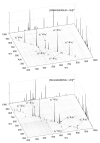Chimera Spectrum Diagnostics for Peptides Using Two-Dimensional Partial Covariance Mass Spectrometry
- PMID: 34207274
- PMCID: PMC8234510
- DOI: 10.3390/molecules26123728
Chimera Spectrum Diagnostics for Peptides Using Two-Dimensional Partial Covariance Mass Spectrometry
Abstract
The rate of successful identification of peptide sequences by tandem mass spectrometry (MS/MS) is adversely affected by the common occurrence of co-isolation and co-fragmentation of two or more isobaric or isomeric parent ions. This results in so-called `chimera spectra', which feature peaks of the fragment ions from more than a single precursor ion. The totality of the fragment ion peaks in chimera spectra cannot be assigned to a single peptide sequence, which contradicts a fundamental assumption of the standard automated MS/MS spectra analysis tools, such as protein database search engines. This calls for a diagnostic method able to identify chimera spectra to single out the cases where this assumption is not valid. Here, we demonstrate that, within the recently developed two-dimensional partial covariance mass spectrometry (2D-PC-MS), it is possible to reliably identify chimera spectra directly from the two-dimensional fragment ion spectrum, irrespective of whether the co-isolated peptide ions are isobaric up to a finite mass accuracy or isomeric. We introduce '3-57 chimera tag' technique for chimera spectrum diagnostics based on 2D-PC-MS and perform numerical simulations to examine its efficiency. We experimentally demonstrate the detection of a mixture of two isomeric parent ions, even under conditions when one isomeric peptide is at one five-hundredth of the molar concentration of the second isomer.
Keywords: chimera spectra; tandem mass spectrometry; two-dimensional partial covariance mass spectrometry.
Conflict of interest statement
The authors declare no conflict of interest.
Figures



Similar articles
-
Two-Dimensional Partial Covariance Mass Spectrometry for the Top-Down Analysis of Intact Proteins.Anal Chem. 2021 Aug 10;93(31):10779-10788. doi: 10.1021/acs.analchem.1c00332. Epub 2021 Jul 26. Anal Chem. 2021. PMID: 34309360
-
Proteomic Database Search Engine for Two-Dimensional Partial Covariance Mass Spectrometry.Anal Chem. 2021 Nov 16;93(45):14946-14954. doi: 10.1021/acs.analchem.1c00895. Epub 2021 Nov 1. Anal Chem. 2021. PMID: 34723513
-
Deconvolution of mixture spectra and increased throughput of peptide identification by utilization of intensified complementary ions formed in tandem mass spectrometry.J Proteome Res. 2013 Jul 5;12(7):3362-71. doi: 10.1021/pr400210m. Epub 2013 Jun 19. J Proteome Res. 2013. PMID: 23725413
-
Towards analytically useful two-dimensional Fourier transform ion cyclotron resonance mass spectrometry.Anal Bioanal Chem. 2013 Jan;405(1):51-61. doi: 10.1007/s00216-012-6422-8. Epub 2012 Oct 18. Anal Bioanal Chem. 2013. PMID: 23076397 Review.
-
The spectral networks paradigm in high throughput mass spectrometry.Mol Biosyst. 2012 Oct;8(10):2535-44. doi: 10.1039/c2mb25085c. Mol Biosyst. 2012. PMID: 22610447 Free PMC article. Review.
Cited by
-
Deep learning-driven fragment ion series classification enables highly precise and sensitive de novo peptide sequencing.Nat Commun. 2024 Jan 2;15(1):151. doi: 10.1038/s41467-023-44323-7. Nat Commun. 2024. PMID: 38167372 Free PMC article.
-
Expert Algorithm for Substance Identification Using Mass Spectrometry: Application to the Identification of Cocaine on Different Instruments Using Binary Classification Models.J Am Soc Mass Spectrom. 2023 Jul 5;34(7):1235-1247. doi: 10.1021/jasms.3c00090. Epub 2023 May 31. J Am Soc Mass Spectrom. 2023. PMID: 37254938 Free PMC article.
-
Ultra-Accurate Correlation between Precursor and Fragment Ions in Two-Dimensional Mass Spectrometry: Acetylated vs Trimethylated Histone Peptides.J Am Soc Mass Spectrom. 2023 Apr 5;34(4):608-616. doi: 10.1021/jasms.2c00319. Epub 2023 Mar 17. J Am Soc Mass Spectrom. 2023. PMID: 36930827 Free PMC article.
-
Expert Algorithm for Substance Identification Using Mass Spectrometry: Statistical Foundations in Unimolecular Reaction Rate Theory.J Am Soc Mass Spectrom. 2023 Jul 5;34(7):1248-1262. doi: 10.1021/jasms.3c00089. Epub 2023 May 31. J Am Soc Mass Spectrom. 2023. PMID: 37255332 Free PMC article.
References
-
- Zhang N., Li X.J., Ye M., Pan S., Schwikowski B., Aebersold R. ProbIDtree: An automated software program capable of identifying multiple peptides from a single collision-induced dissociation spectrum collected by a tandem mass spectrometer. Proteomics. 2005;5:4096–4106. doi: 10.1002/pmic.200401260. - DOI - PubMed
MeSH terms
Substances
Grants and funding
LinkOut - more resources
Full Text Sources

